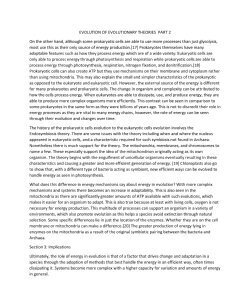EVOLUTION OF EVOLUTIONARY THEORIES On the other hand, although some prokaryotic cells are able to use more processes than just glycolysis, most use this as their only source of energy productioPART 2
EVOLUTION OF EVOLUTIONARY THEORIES On the other hand, although some prokaryotic cells are able to use more processes than just glycolysis, most use this as their only source of energy productioPART 2
EVOLUTION OF EVOLUTIONARY THEORIES PART 2
On the other hand, although some prokaryotic cells are able to use more processes than just glycolysis, most use this as their only source of energy production.[17] Prokaryotes themselves have many adaptable features such as how they process energy which are of a wide variety: Eukaryotic cells are only able to process energy through photosynthesis and respiration while prokaryotic cells are able to process energy through photosynthesis, respiration, nitrogen fixation, and denitrification.[18] Prokaryotic cells can also create ATP but they use mechanisms on their membrane and cytoplasm rather than using mitochondria. This may also explain the small and simpler characteristics of the prokaryotic as opposed to the eukaryote and eukaryotic cell. However, the external source of the energy is different for many prokaryotes and prokaryotic cells. The change in organism and complexity can be attributed to how the cells process energy. When eukaryotes are able to dissipate, use, and produce energy, they are able to produce more complex organisms more efficiently. This contrast can be seen in comparison to some prokaryotes in the same form as they were billions of years ago. This is not to discredit their role in energy processes as they are vital to many energy chains, however, the role of energy can be seen through their evolution and changes over time.
The history of the prokaryotic cells evolution to the eukaryotic cells evolution involves the Endosymbiosis theory. There are some issues with the theory including when and where the nucleus
